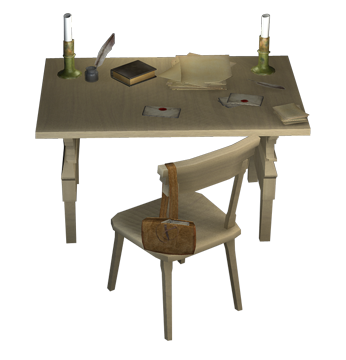Object Descriptions Ground Floor Parlor
Desk, with Letters
This desk, with a pouch and various papers and letters on and around it, indicates Spenser’s background as both a messenger and a secretary to Lord Deputy of Ireland Arthur, Lord Grey (from 1580-82). The letters are sealed with red wax. In the context of the 1590s at Kilcolman, the desk demonstrates how the day-to-day business of managing his Munster estates, while receiving and responding to news from elsewhere, would have occupied much of his time.
Almost all surviving examples of Spenser’s handwriting are in the form of letters copied while secretary to Grey or writing on behalf of other administrators, such as John Norris, President of Munster, one of his planter neighbors nearby to the south (at Mallow Castle, County Cork). Few letters survive from Spenser’s time in Munster, however.
Spenser wrote and received both administrative as well as personal letters; some of the latter, exchanged with the scholar Gabriel Harvey while Spenser lived in England in the 1570s, were published in 1579. They focus on newsworthy events in England and abroad as well as current debates about poetic aesthetics.

In the study in the Tower House portion of this castle recreation is another desk. That room functions as Spenser’s private “office” for other, more creative writing.
Both desks are modeled loosely on that of St Jerome in Albrecht Dürer’s famous print (pub. 1514).
Literary Connections
Irenius in A View of the Present State of Ireland describes how the Irish are always asking for news, which is carried across the country by “common carriers”, men who are akin to rogues and “loose fellows.” These low-life criminals are “partakers not only of many stealths by setting forth other mens’ goods to be stolen” but they are “also privy to many traitorous practices.” Eudoxus answers that the Irishman’s desire for news “argueth sure in them a great desire of innovation” (View 76). Eudoxus’ comment, following so closely upon Irenius’ warning, hints at his fear of dangerous political innovation, including treason, which can spread so swiftly along with the news in Ireland. Spenser is concerned about the unchecked spread of information across the country in troubled times.
The news also helped those in need. In the “Mutabilitie Cantos” portion of The Faerie Queene, people of “the lower World” are confused when the light of Cynthia, or the moon, is momentarily extinguished by the attempted overthrow of her power: her throne in the heavens has been shaken by the rebellious titaness, Mutability. “Fearing least Chaos broken had his chaine,/ And brought againe on them eternall night”, the messenger-God Mercury takes action and speeds to the “faire Palace” of the king of the Gods, Jove, to tell him what has happened. Mercury, “The Heauens Herald” then acts as go-between for Jove and Mutability (FQ VII.vi.13-19).
Spenser himself is compared to Mercury in a commendatory sonnet written by Sir Walter Raleigh in praise of The Faerie Queene. In the poem, published alongside the epic in the 1590 edition, Raleigh compares Spenser to a “celestiall theife” of the glory of previous poets (Raleigh, “A Vision vpon this conceipt of the Faery Queene,” 14). The “theife” is Mercury, who is also the god of thieves; in Greek myth, Mercury steals the cattle of Apollo. Mercury’s dual role as thief and messenger may help explain the connection in Irenius’s mind (above) between thieving activity in the countryside and running news. Indeed, Spenser was himself accused in a letter (October 12, 1589) to Queen Elizabeth by his antagonistic neighbor, Lord Roche, of having stolen his cattle and beating his men.
In an accompanying sonnet, also by Raleigh, he declares that “Of me no lines are lou’d, nor letters are of price,/ Of all which speak our English tongue, but those of thy deuice” (Raleigh, “Another of the same,” pub. 1590, 13-14). The immediate reference here is to “lines” and “letters” of verse, i.e., to the poems written by Spenser that Raleigh admires. The “deuice” has to do with Spenser’s powers of invention while writing them (his devising of them). A secondary meaning occurs, however, in that a device, or personal emblem, was used to mark wax seals on letters as a further method of identifying them (no such “device” of Spenser’s exists today, although he would have been entitled to one, according to his rank as a landed “gentleman” at Kilcolman). Raleigh may therefore be hinting at the method by which he received poetry from Spenser, i.e., in letters of Spenser’s devising and with Spenser’s device on them. Simultaneously, such letters in the “English tongue” coming out of Ireland, especially, would attest to their shared nationality.
Bibliography:
James Bednarz, “The Collaborator as Thief: Ralegh’s (Re)Vision of ‘The Faerie Queene’”. English Literary History 63.2 (summer 1996), 297-307: 298-9.
Douglas Brooks-Davies, “Mercury.” The Spenser Encyclopedia. Ed. A. C. Hamilton (Toronto: U of Toronto P, 1990), 469-70.
Andrew Hadfield, Edmund Spenser: A Life (Oxford: Oxford UP, 2012): 106-9, 158-9, 188.
Judith Rice Henderson, “letter as genre.” The Spenser Encyclopedia. Ed. A. C. Hamilton (Toronto: U of Toronto P, 1990), 433-4.
Edmund Spenser, Selected Letters and Other Papers. Ed. Christopher Burlinson and Andrew Zurcher (Oxford: Oxford UP, 2009).
H.R. Woudhuysen, “letters, Spenser’s and Harvey’s.” The Spenser Encyclopedia. Ed. A. C. Hamilton (Toronto: U of Toronto P, 1990), 434-5.